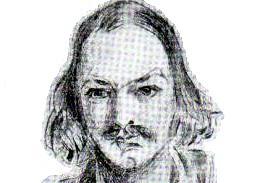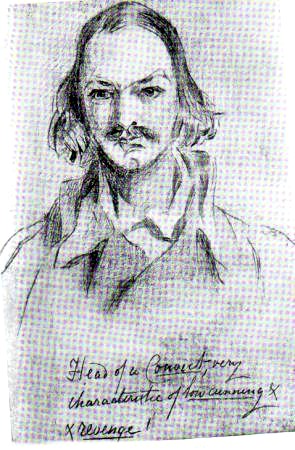Thomas Griffiths Wainewright (October 1794 – 17 August 1847) was an artist, writer and infamous poisoner.
Early life
Wainewright was born into affluence and London literary society in Richmond, London, England but was orphaned when he was very young.
His father's identity has never been firmly established. He may have been an apothecary, although it is more likely that he was a lawyer and came from a family that practiced the law over many years. He died when Thomas was a boy.
His mother died giving birth to him but of her interesting background we have a very complete picture. She was Ann, the daughter of Ralph Griffiths (1720-1803), for many years the editor of The Monthly Review.
Thomas and his father lived in an extended family situation with his maternal grandfather at Linden House at Turnham Green in what was then London's rural periphery. Griffiths was well connected in the literary world and Thomas must have profitted from the society that visited Griffiths home. When Griffiths wrote his will in 1803 Thomas's father was already dead and he himself died later in that year.
The child then came under the care of his maternal uncle, George Griffiths. He was educated at the expense of his distant relative, Dr. Charles Burney, the son of the musicologist and the headmaster of the Greenwich Academy which Wainewright attended. His background was most advantageous and his early adulthood was the evidence that he profitted from it.
Wainewright subsequently served as an officer in the guards and as cornet in a yeomanry regiment.
Literary career
In 1819 he embarked on a literary career, and began to write for The Literary Pocket-Book, Blackwoods Magazine and The Foreign Quarterly Review. He is, however, most closely linked with The London Magazine, to which, from 1820 to 1823, he contributed some clever but flippant art criticism and articles under the noms-de-plume of Janus Weathercock, Egomet Bonmot and Cornelius van Vinkbooms. His success in publication would have been assisted by his famous grandfather.
Wainewright was a friend of Charles Lamb who thought well of his writing and in a letter to Bernard Barton, styles him "the kind, light-hearted Wainewright." He also practised as an artist and was trained by John Linnell and Thomas Phillips. He exhibited at the Royal Academy.
He made illustrations for Chamberlayne's poems, and from 1821 to 1825 he exhibited narratives based on literature and music at the Royal Academy, including a Romance from Undine, Paris in the Chamber of Helen and the Milkmaid's Song. None of these works survive.
Criminal
Owing to his extravagant habits - he was somewhat of a dandy - Wainewright's affairs became deeply involved. In 1830 he insured the life of his sister-in-law with various companies for a sum of £18,000, and, when she died in the December of the same year, payment was refused by them on the ground of misrepresentation.
Wainewright retired to Boulogne in July Monarchy France, was seized by the authorities as a suspected person and imprisoned for six months. He had in his possession a quantity of strychnine, and it was afterwards found that he had poisoned, not only his sister-in-law, his uncle, but also his mother-in-law and a Norfolk friend, although this is disputed.
He returned to London in 1837, but was at once arrested on a charge of forgeing thirteen years before and a transfer of stock. It would seem that the authorities used the tenable case of forgery to transport him for life for the unproveable murders. He was sent to Hobart Town on the Susan, arriving 21 November 1837.
Late life and legacy
During his ten years in the colony he did eventually enjoy a certain amount of freedom. After initially working on the road gang he became an orderly in the hospital and he was able to work as an artist and painted portraits in the homes of his subjects.
Wainewright completed over one hundred portraits on paper using coloured wash, pencil and ink during his years in Hobart. They survive not only in public museums, but also in private collections throughout Australia, some having remained in the families of his sitters.
They depict the officialdom, professionals and members of the elite, husbands, wives and children, of early Hobart. Many, particularly those of women and children, are in a Romantic Regency style with the sitters somewhat languidly posed if the portraits show more than heads and shoulders.
Wainwright has been summararily dismissed as a mawkishly sentimental painter of women, and although the female portraits do not comprise the greater part of the body of his work, amongst the most distinctive of his paintings are portraits of women and children. Many of these Tasmanian portraits are of considerable importance in the documentation of the colony's historically significant figures. A self-portrait was completed in this period.
Wainewright had a conditional pardon granted 14 November 1846, he died of apoplexy in the Hobart Town hospital on 17 August 1847. He is buried in an unknown grave.
The Essays and Criticisms of Wainewright were published in 1880, with an account of his life, by W. Carew Hazlitt; and the history of his crimes suggested to Charles Dickens his story of Hunted Down and to Edward Bulwer-Lytton, 1st Baron Lytton his novel of Lucretia.
His personality, as artist and poisoner, has interested latter-day writers, notably Oscar Wilde in Pen, Pencil and Poison (Fortnightly Review, Jan. 1889), and A. G. Allen, in T. Seccombe's Twelve Bad Men (1894).
Wainewright has been the subject of three biographical studies: Janus Wethercock by Jonathan Curling (Thomas Nelson and Sons, London, 1938) and Robert Crossland's Wainewright in Tasmania (OUP, Melbourne, 1954), and more recently his life and writings, and that which has been written about him were the basis of the poet Andrew Motion's creative biography, Wainewright the Poisoner (2000).
It is likely, as suggested by Havelock Ellis, that Wainewright was never normal after the hypochondriac period of his life when he was on the verge of insanity if not actually insane.
Wikipedia.org


